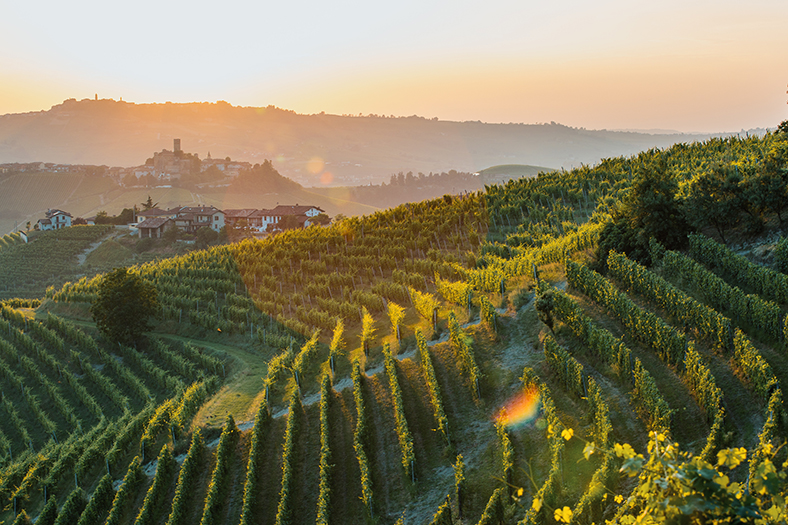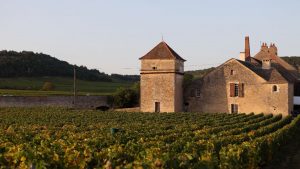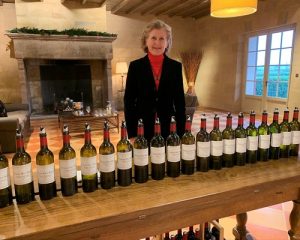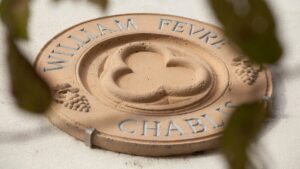
The wine world is somewhat partial to a debate between styles that are “old” and those that are “modern”. And enthusiasts sometimes find themselves divided; on one side we have people who enjoy wines made following the newest trends in oenology, and on the other are the stalwarts of tradition who like their wine old-fashioned. This spat is particularly lively in the Barolo appellation.
In the private collection up for auction until the 21st October, there is a lovely selection of bottles from Italy, most notably a series of Barolo cuvées from some of the appellation’s finest domains. Perhaps you are more into French wine, or maybe you’re quite new to the mondovino in general, but without being acquainted with Italian wines, you’re likely to be unsure as to what to expect from these bottles, or what style of Nebbiolo will be revealed in the glass. Recognising the character of wines from Bartolo Mascarello and Giacomo Conterno compared to those made by Angelo Gaja and Roberto Voezio might not be your strong suit just yet. The former are traditional wines, the latter made in a more modern way…and behind these words lie two rather different worlds.
The Barolo appellation
The landscape of Barolo, south of Turin, is magnificent; the lush hills are bestrewn with vines, hazel bushes, and fruit trees, with quaint villages and historic villas smattered along the way. There is a certain magic to it. The region’s vine-growing land covers around 1,250 hectares overall, for an annual production of about 8 million bottles. The one and only varietal grown here is the Nebbiolo grape, Piedmont’s noble fruit, first planted here in the 19th century. By then it was already the dominant varietal in Upper Piedmont appellations such as Gattinara and Lessona.
If we were to compare Barolo to a French appellation or viticultural region, Burgundy is the one that comes to mind (perhaps the Côte de Nuits, more specifically). This is due to the natural features of the Nebbiolo grape (low in colour, lovely acidity) which, over the course of ageing, can be reminiscent of the Pinot varietal, except a little more tannic. Another similarity between the two is the recognition of terroir, always identifiable in the best cuvées. Unlike Burgundy, however, there is no hierarchy of premier and grand cru in Barolo.
The Nebbiolo grape is demanding and very late to ripen. To reach the 13% alcohol required by the appellation, the harvests cannot take place before the end of September, a wait that has consequences for how the grapes are vinified.
The appellation has two, distinct soil types, and this goes a long way to explaining the differences we find in its various wines. In general, the western side (Verduno, La Morra, Barolo, and Novello) has soil rich in compact, chalky marl, quite fresh and fertile, that gives relatively delicate, aromatic wines. These can be made more quickly than those from the other side. The eastern area of the appellation (Castiglione Falletto, Monforte d’Alba, and Serralunga d’Alba) has more sandstone and clay, and the soil is less compact and less fertile, producing structured, powerful, and intense wines that age more slowly.
Maturation is regulated to an extent we don’t really see in France, and it’s not the simplest system. The wine must legally be matured for 36 months (24 of which in wood, the rest in the bottle), 60 months for Riserva versions (36 in wood). Selling is also regulated; bottles can only be put up for sale from the 1st January that follows the fourth year after harvesting. For example, the 2014 harvest was only able to be sold in bottles from 1st January 2018 (2019 for Riserva). And this is only the earliest date, with some producers releasing their cuvées well after the legal minimum.
Vinification, at the heart of the debate
To illustrate the intensity of the debate around vinification in Barolo, one family ended up building a wall to divide their vineyard in two, so radically different were two brothers’ ideas on how their wine should be produced…
Firstly, as has already been mentioned, Nebbiolo is a late-ripening varietal. This means that when fermentation begins around mid-October, the cellars are already cold, so fermentation is slow to get going. Since the cellars will only get cooler at this point, it can take a long time for the grapes to ferment fully, at least two to three months. The natural consequence of this would be an advanced extraction of the tannins that necessitates a long maturation in foudres for at least five years, if not more.
At the end of the 1980s, some producers started seeking another path. For them, the old-fashioned Barolo wasn’t a success: very long macerations, maturing for years in foudres, giving wines with a dry finish that you had to wait at least twenty years to drink. According to them, consumer tastes had changed, and they wanted to produce rounder, easier wines with fruitier aromas using modern oenological techniques. They put the fruit front and centre, maintaining fermentation temperatures below 28°, limiting fermentation and maceration lengths, using casks rather than foudres for softer tannins, and bottling their cuvées quicker. The use of vats with a spinning helix became widespread, allowing for better extraction and reducing maceration time to just 10 days. At the end of alcoholic fermentation, the cellar is heated to facilitate malolactic fermentation, and this reduces the aggressive acidity that can sometimes be present in traditional Nebbiolo cuvées.
To convince the American market, producers started making fleshier Barolos with oaky flavours and a higher alcohol percentage, even sometimes completed with a hint of sweetness. The most emblematic of these producers is Angelo Gaja, whose name has become somewhat of an international brand, promising delightful, universal wines.
The traditionalists, whilst refusing to hanker to the international market, haven’t settled with producing Barolos just like those from the 1950s. Most have remained loyal to using indigenous yeasts for fermentation, though this has been shortened from 30 to 20 days. The vats aren’t equipped with things like revolving helixes, so the grapes are extracted in a classic way, usually involving pumping over; this is when the juice at the bottom of the barrel is transferred to the top, submerging the cap. Giacomo Conterno was always the gatekeeper of the traditional way. When he passed away, his two sons soon went their separate ways, pushed apart by their differing approaches to wine making. Giovanni kept to the paternal tradition he knew and loved, whilst Aldo braved a new start, founding his own domain which sits between tradition and the new school. He saw this as a way of dusting off classic production. Their sons now run their respective domains, entrenching the fork in the family tree…
The best Barolo domains: our top picks
Our current sale has plenty of Barolo cuvées from the traditional school, and fans of fine Nebbiolo will be delighted! We have 12 wines from Giacomo Conterno, seven of which are his finest Monfortino cuvée. Then there’s a beautiful series from domain Bartolo Mascarello. This domain, unlike most others, produces only one cuvée from vines grown in different parcels. This is wine produced with tradition in mind, including a very long maturation in foudres. This domain, considered by many seasoned enthusiasts to be one of the best, has been managed for a few years by Maria Teresa Mascarello, who inherited the estate from a rather masculine lineage. This domain is also known for its labels, printed with the phrase “No barrique, No Berlusconi” to express a commitment to traditional Barolo as well as a clear political statement! Forty bottles from Rinaldi present a superb opportunity to taste some truly fine wines. Finally, to try a traditional wine from a younger producer, Luca Roagna took up his family domain around 15 years ago, modernising it all whilst preserving tradition; he carries out long maturations, especially for the finest, single-parcel cuvées from the oldest vines.
This is a selection of exceptional wines that you very rarely find all in one place!




